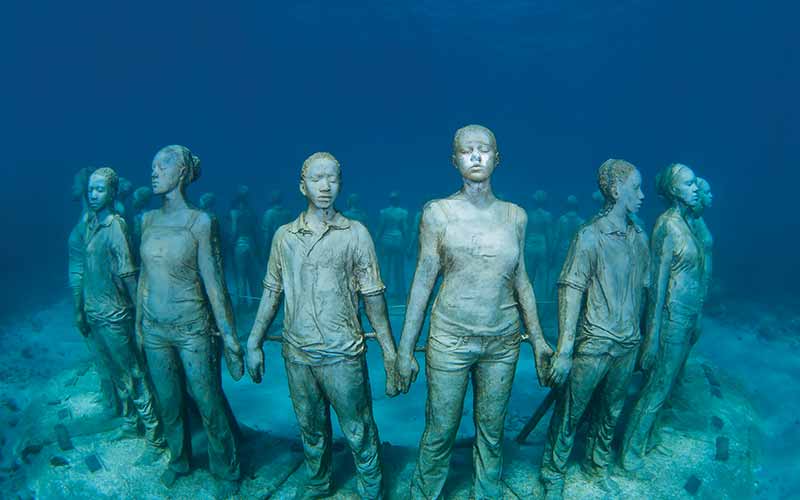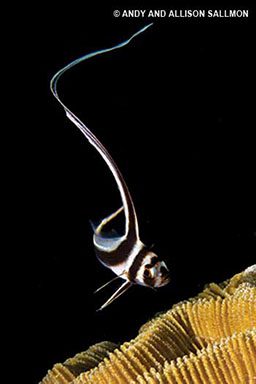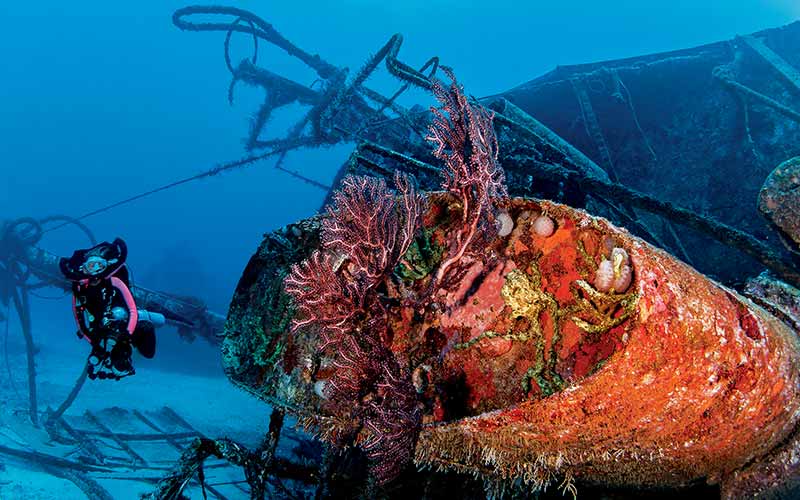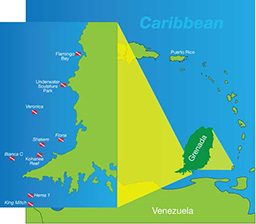My buddy looked over at me, raised an eyebrow and said, “Are you ready to see something cool? Dive, dive, dive!” He positioned his mouthpiece and splashed.
I laughed. He knew I wasn’t a huge fan of wreck dives. I was certainly happy to give this site a look, but let’s just say I was eagerly anticipating an afternoon reef dive.

I checked my own rebreather mouthpiece and handset one last time and jumped into the ocean. After descending a few feet for a bubble check, we followed the divemaster to our agreed depth of 100 feet. An unexpected current was present, and looking around I saw only blue water. I sighed. There was no sign of the Bianca C, the legendary shipwreck we’d come all this way to dive. But on the bright side, maybe that meant we’d head over to the reef early.
I glanced over at our guide, anticipating his signal to ascend. Instead, he looked down at the sand 70 feet below us and then pointed decisively to our right and asked if we were OK to swim for a minute. We agreed and began kicking into the current. Within the promised minute a huge structure became visible. A few more kicks and it became recognizable as the upright bow of an enormous ship.
I felt my attitude undergoing a major adjustment as I was transported into a real-life television special. This shipwreck has been called “The Titanic of the Caribbean,” and it was easy to tell where the moniker originated. I stopped for a moment in front of the ship, dropping a bit to take in her majestic size. Below me at 170 feet, I could easily make out an anchor embedded in the sand. Above me at 90 feet, her gracefully curving bow was festooned with sponges and whip corals. And right in front of me the massive hull narrowed to an incongruously tiny edge that I could easily span with two fingers. All thoughts of reef dives abandoned, I began adjusting my camera settings. I had a shipwreck to explore.
This place was different.
I probably should have caught on to that before we ever left the airport. But it wasn’t the warm reception at immigration that tipped me off, nor was it the Grenadian family who chatted with us easily at baggage claim, telling us how happy they were to be home. It wasn’t even the tranquil silence that descended as we exited the arrivals lounge — no chaotic taxi line or clamoring would-be tour guides in sight. As it turned out, I was clued in during a dive briefing. You see, the tale of the Bianca C goes beyond depth, structure and marine life. The story of her sinking provides a glimpse not only into Grenada’s history but also into the very nature of the island and its warm and hospitable people.

In 1961 the Italian luxury liner was a familiar visitor to the island’s outer harbor and represented an impressive sign of the island’s burgeoning tourist industry. One October morning, her crew was preparing to weigh anchor for the long trip home when tragedy struck. An explosion in the engine room ignited a fire that rapidly engulfed the ship, which carried nearly 700 passengers and crew members. As the crew scrambled to launch the few unaffected lifeboats from the burning liner, Grenadians on shore quickly organized an armada of rescue vessels that ran the gamut from ritzy yachts to battered rowboats.
This rapid response undoubtedly altered the outcome, and all but one person were brought to land. Unsurprisingly, the significant population influx quickly overwhelmed local guest accommodations. Anywhere else, survivors may have found themselves housed in hastily constructed camps, but not here. On Grenada, many stray passengers were welcomed into local homes to be fed, clothed and generally treated as family until return transport to Europe could be arranged.
This story became a defining one during the course of my visit. I soon noticed that everywhere we went, we were greeted by affable, smiling Grenadians who were quick to ask us how our dives were and encourage a return holiday (or better yet, an indefinite extension of our current stay). By the end of our trip we couldn’t help but seriously consider it.
The Bianca C and Beyond

Two days after the explosion, the still-smoking Bianca C was towed out of the shipping channel, ultimately sinking near Gin Pink Beach at the southern tip of the island. She came to rest on her keel, becoming a mesmerizing backdrop for marine life and easily one of the best wreck dives in the Caribbean.
Fifty-two years later and 170 feet beneath the ocean’s surface, we’re taking full advantage. As we slowly fin past the stern, I admire sponge-encrusted propeller pipes and branches of black coral swarming with tiny fish as I attempt to envision the tragedy that bore this incredible dive site. The middle of the wreck is partially collapsed, but it is easy to identify davits (small cranes used to raise and lower lifeboats), the rear mast, a funnel and a swimming pool. Subsequent dives on the 600-foot liner allowed us to slowly explore her imposing bow and spooky anchor locker as well as her forward masts, which were coated with clusters of yellow vase sponges that comically resembled suspended bunches of bananas. During each visit to the wreck, eagle rays and large barracudas passed by us, and one extended deco stop provided a fleeting but incredible sight: a huge marlin.

Ascending from the Bianca C, it was hard to imagine other local wreck dives comparing favorably. How could another site possibly compete? Fortunately for divers, Grenada is home to a thriving nutmeg industry (hence its nickname, the “Isle of Spice”), and it lies along a shipping lane of Trinidad. These factors ensure a constant flow of maritime traffic and, statistics being what they are, more than one vessel has ended up on the ocean floor.
One calm day we were happily surprised when our dive boat motored toward the Atlantic side of the island rather than the Caribbean. The Atlantic shipwrecks are renowned but visited only in ideal conditions since their exposed location often means topside swell and swift currents underwater.
“You want to see sharks, right?” asked our guide. “I thought I’d show you a few.”
I follow a drop line down 120 feet to the wreck of the King Mitch, a minesweeper-turned-merchant-vessel that sank when its cargo shifted in 1981. We’re four miles offshore, and the divemaster reminded us of the potential dangers here; we descended as a team, and we used a large surface marker buoy for our ascent and decompression stop. The wreck itself, a boxy vessel with an angular hold containing bags of cement, is somewhat lackluster. However, the creatures it attracts make it an extraordinary destination. A pile of large nurse sharks lies tucked under the wreckage, but they quickly scatter when approached by our group of eager divers. The visibility here is spectacular, and I watch as eagle rays and reef sharks circle at a distance for the entire dive.
When we surface the swell has picked up, but it is just calm enough to allow another dive. Our destination, a freighter named Hema 1, sank two miles from shore in rough seas in 2005. She lies on her port side in 110 feet of water, and her picturesque structure is largely intact. Although the Hema 1 is a recent addition to Grenada’s array of shipwrecks, sponges and cup corals are already starting to cover portions of her deck and hull, and a few small sea fans adorn the smokestack. A strong current hinders our approach, and I watch jealously as a large hawksbill turtle swims lazily past. Eagle rays hover in the distance, and large schools of snapper swarm overhead and in open holds at the stern.
I am modeling for my dive buddy next to the stack when a dark shape catches my eye — a large Caribbean reef shark makes a rapid, close pass to check us out, then another and another. By the time we’ve reached our agreed-upon bottom time, the eagle rays have begun venturing closer as well. It takes some strong willpower to begin our ascent, and I know we’re all hoping for a repeat dive on this incredible site. By the time we surface, however, the swell is so big that simply getting back onto the boat is dicey, so thoughts of doing a third Atlantic dive are abandoned. With resignation, we head back to the protected side of the island.
You Call This a Slow Day?
After forays to the current-swept Atlantic wrecks and the intimidating Bianca C, we’ve become conditioned. We show up the next morning prepared for a new challenge, so you can imagine our surprise when we’re told to expect a relatively tame day of diving. Truth be told, we’re fairly exhausted and not terribly upset at the idea of an easier dive day and, as advised, lower our expectations a little.

Our deepest dive will be the Shakem, which sank in 2001 when its cargo of cement shifted (see a pattern here?). This wreck, which sits upright in 100 feet of water at the harbor’s entrance, is one of Grenada’s most recent, so we’re not expecting much in the way of growth on it. Imagine our surprise when we descend to discover that this intact wreck is brimming with life. Whip corals, gorgonians and colorful encrusting sponges dominate the propeller and stern, making for one of the best photo opportunities of our trip. Among the intriguing structures on the stern deck are tethered propane tanks that resemble outsized air cylinders, and these spark banter about who in our group is most in need of additional gas volume.
As we move toward the bow there is plenty more to appreciate about this “tame” dive site. The wheelhouse is adorned with branches of black coral swept with schools of tiny fish, and the crane and surrounding wreckage are decorated by neon yellow vase sponges. We explore the wreck happily until our dive guide approaches us and excitedly gestures for us to follow him. We ascend to the deck above the wheelhouse, and he points out one of our most-wanted photo subjects: a gorgeous, bright orange seahorse perfectly situated on the uppermost railing.
Our surface interval can’t pass quickly enough. Now that we have borne witness to the Grenadian version of a subdued dive site, we realize the truth: Such a thing doesn’t really exist. Our second dive, on the Veronica, confirms this fact. This small ship sits on her keel amid a pretty reef just off Grand Anse beach, and at a maximum depth of 50 feet she is suitable even for novice divers. She is also completely covered with cup corals and rope, vase and encrusting sponges, making her one of the loveliest dive sites we’ve visited. The fish life here is astounding; dense schools surround the wheelhouse and broken crane. Scorpionfish lie in wait on the nearby reef, tiny secretary blennies peep out of holes along the deck railings, and an adorable black brotula emerges from his hiding place behind a small sea fan to check out my camera gear.
In the afternoon, we continue the day’s shallow theme by visiting the wreck of the Fiona, a cargo ship that lies adjacent to an unknown barge (giving this site the alternate name of Twin Wreck) in 50 feet of water. I’ve heard that there can be large groups of squid at this site, and I nearly enter the water with a camera set up to photograph wide vistas. As the afternoon clouds gather, however, I impulsively change my mind and decide to bring a camera more suited for shooting smaller marine life. Once submerged, I quickly realize the good fortune of my decision; the beauty of this site isn’t in the big stuff but in the tiny critters, which are varied enough to impart a decidedly Indo-Pacific feel. I easily spot colorful shrimp tucked into anemones, fire bristle worms crawling along the hull and a shy juvenile cowfish peering at me from behind a sponge.

A Cure for What Alis You
I’ll admit it: After my first glimpse of the Bianca C, all thoughts of diving Grenada’s reefs were eclipsed by a whopping case of shipwreck fever. However, my early comments about hoping to visit some reefs had not gone unnoticed by the dive staff. On our final day, as we’re trying to persuade the captain to revisit the Atlantic wrecks, our guide insists we cannot depart without experiencing a few well-known reef sites. Sure enough, Kohanee Reef and Black Wall, adjacent sites that range from 30 to 90 feet, are stunning counterparts to the beautiful wrecks we’ve been diving. Currents here have encouraged the growth of one of the most lush reefs I’ve seen anywhere in the Caribbean. The dive passes quickly as we explore a jumble of large sea fans, whip corals and gaudy, multicolored sponges. During our safety stop, I am happily following a group of reef squid in the shallow water when I notice my dive buddy gesturing to get my attention; I quickly turn to see a school of large wahoo passing nearby. I instantly feel a pang of regret at our impending departure, and I have the distinct feeling I should have spent more time pursuing reef diving.

For our final dives, we head to Moliniere Marine Park. We‘ve specifically requested a visit to Flamingo Bay, where we’ve heard we might spot jawfish. This reef, which ranges in depth from 20 to more than 100 feet, turns out to be packed full of interesting small marine life, including juvenile drums, flamingo tongue cowries, Pederson shrimp, pipefish and several banded jawfish. When we surface we’re ready to head back to the resort for packing and a well-earned afternoon rest. However, our captain tells us there is one more spot we really must see before we leave: the nearby Underwater Sculpture Park. This site contains more than 65 sculptures that were placed to encourage coral growth after the surrounding reef was damaged during the 2004 hurricane season. Most of the sculptures are within 30 feet of the surface, attracting snorkelers and divers alike. We search out as many sculptures as we can find, admiring the sponges that cover the older ones and photographing the unafraid French angelfish that seem to be everywhere.
Our departure day finally arrives, and we glumly maneuver luggage carts stacked high with teetering gear toward the airline check-in desk. We reluctantly hand over our passports to the woman behind the counter who, familiar with depressed outgoing tourists, greets us with a warm smile. After expressing good-natured disbelief about the obscene amount of luggage we’re carrying, she eventually says, “I just have to know. What in the world is in all of these bags?”
As we begin cataloging the impractical amount of dive and photographic gear we brought with us, we begin chuckling. Soon I am openly laughing along with the agent. When we finish our long inventory, we conclude by telling her what a wonderful visit we had. She grins wickedly and begins tapping away at her computer.
“You know,” she says, raising an eyebrow, “we can always extend your stay. Perhaps you’d prefer an open-ended ticket?”
We decline, but as we walk toward the security gate, we glance meaningfully at one another.
Not this time, Grenada. Not this time. But next time? Perhaps.
Getting Technical
Shipwrecks and advanced diving often go hand in hand, and this is certainly true in Grenada. The Bianca C, which begins at 90 feet and drops to 170, can be explored as a recreational dive by experienced divers, but its depth makes it ideal for technical diving. Even with prolonged bottom times that include decompression, this massive site is still best savored on a series of dives. It is worth noting that the Bianca C is beginning to collapse, so extensive penetration is no longer permitted by most dive operations.
Many other sites, such as the King Mitch, Hema 1 and Shakem, are also at depths that are well-suited for technical diving. Rebreathers may also afford divers a better chance to get close to large creatures, such as eagle rays, sharks and billfish.
We chose to dive closed-circuit rebreathers (CCRs) on our most recent visit. Aquanauts Grenada supported our efforts with 2- and 3-liter steel tanks, oxygen and air fills and bailout cylinders. It also offers several rental units for divers who wish to travel light or decide to pursue CCR training during their visit.

Dive In
Grenada is officially located outside of the hurricane belt, though it was hit hard by category-3 Hurricane Ivan in 2004. There is excellent diving here year-round, but visibility can be affected when there is high flow from the Orinoco River during the midsummer rainy season in nearby Venezuela.
Rough seas during the windy season (December through April) may limit access to the Atlantic wrecks. Water temperatures range from the low 80s (°F) in the winter to high 80s in the summer. There are hyperbaric chambers on nearby Barbados and Trinidad.
© Alert Diver — Q3 Summer 2013